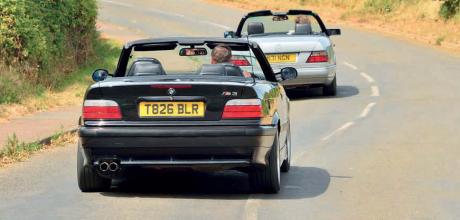1995 Mercedes-Benz E220 Cabriolet A124 vs. 1996 BMW M3 Convertible Evolution E36/2CS
The Mercedes-Benz A124 Cabriolet is one of the classic car world’s most enduring four seaters, but it was expensive when new. How does a similarly priced BMW alternative compare today?
Words: Sam Skelton
Photography: Matt Woods
THE POWER OR THE GLORY?
Cast your mind back to the 1990s, when £40,000 was an awful lot of money. Enough for a pair of semis in Salford, the salary of a Member of Parliament, or over 22,000 Big Macs. It also bought you a lot in the world of motoring; an Audi S6, for instance – or a 4-litre XJ6, a Marcos LM500, or even a V8 Range Rover.
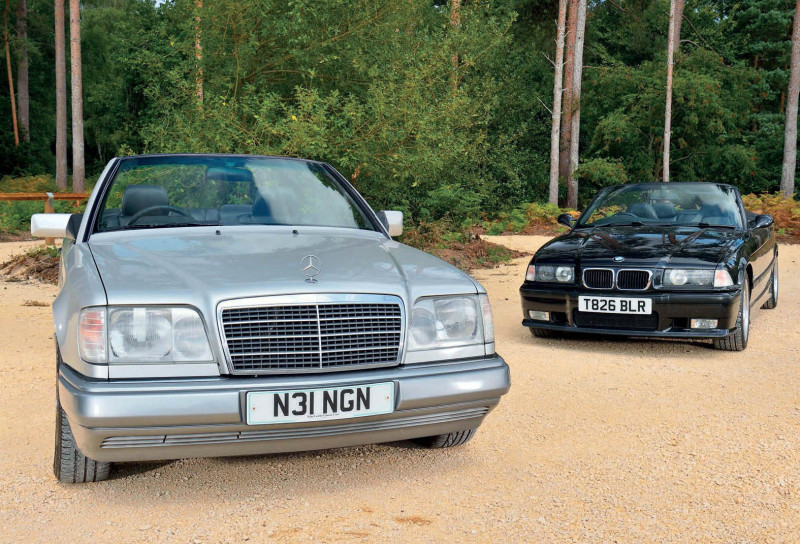
If you wanted a four-seater convertible with a solid image, though, you only really had two options around this price point. Jaguar wanted another £6000 for its XJS, while cars like the Audi Cabriolet were far cheaper. That left the BMW E36 M3 cabriolet at £41,800, or the Mercedes-Benz E220 Convertible at £40,300. These were two very different cars with very different aims when new, but as modern classics the A124 and E36 convertible ranges appear on several of the same shopping lists. While most twin tests would focus on models of equivalent performance and take note of the outlandish price difference when new, we thought it would be more indicative to pitch this pairing based upon their new cost – not only to see which makes for a better car, but which means of spending £40,000 has stood the test of time as a better decision.
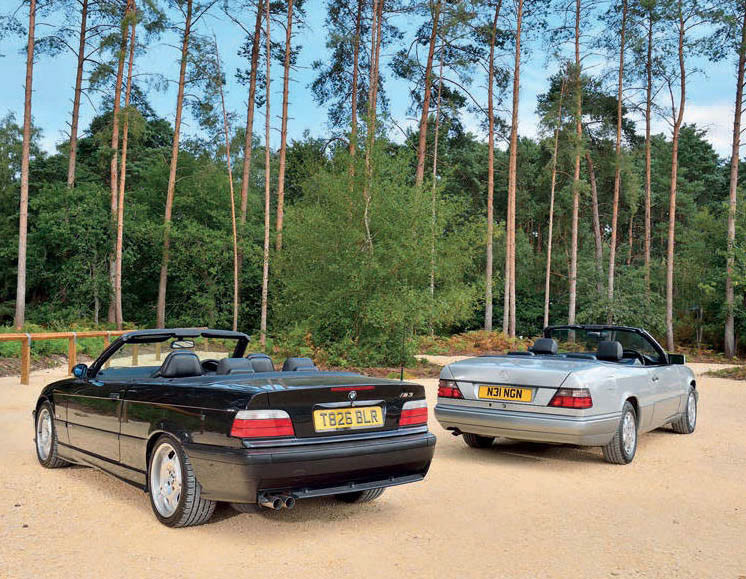
“IT’S SOMEHOW SOFTER THAN BOTH THE CAR IT REPLACED AND THE CAR THAT REPLACED IT”

MERCEDES-BENZ E220 CONVERTIBLE A124
Mercedes launched the W124-series saloon in 1985, as a replacement for the previous W123 series mid-range saloon. That model had never been available from the factory as an open car – nor had any four-seater since the 1971 280SE 3.5. But the W123 had been converted by outside operators, such as Crayford with its 280CE St Tropez.
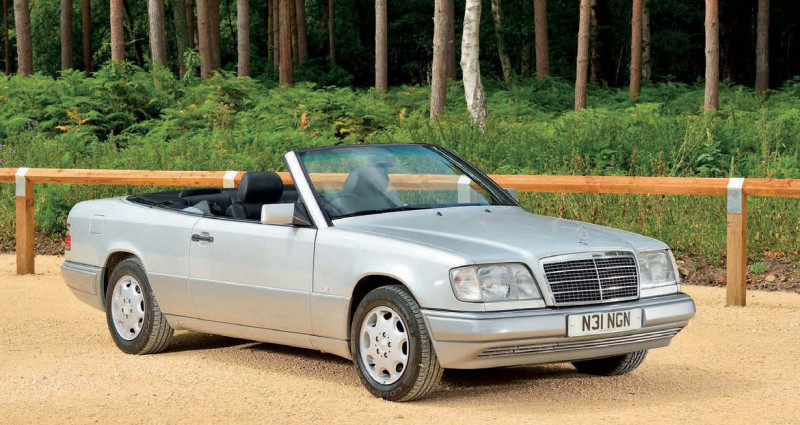
The success of Saab’s 900 and BMW’s 3 Series convertible led Mercedes to develop an open four-seater of its own, positioned above the former models. In 1991 the 300CE Cabriolet was unveiled, along with the 24-valve 300CE-24. Soon after, a four cylinder was made available in the form of the 230CE. New 2.2 and 3.2 litre engines replaced the old units in 1992 for the short-lived 220CE and 320CE models, before the cars were facelifted and renamed E220 and E320 the following year. For 1997 Mercedes introduced the CLK convertible – a class below, but effectively a replacement for the W124. This time, its market position meant it was able to challenge the BMW 3 Series convertible more effectively.
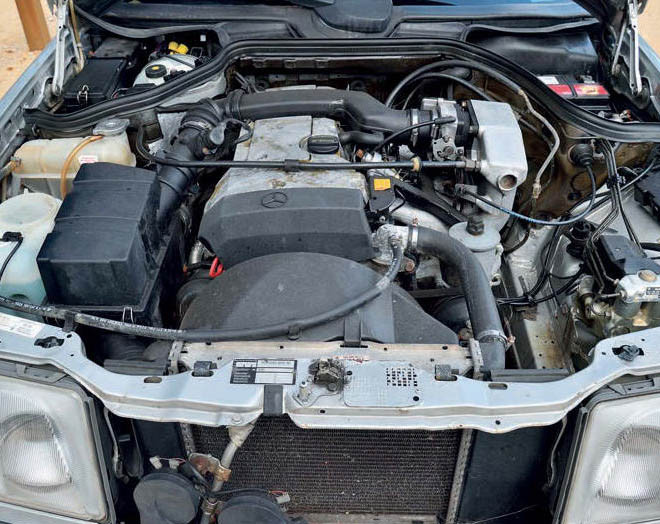
The E220's four-cylinder motor can be surprisingly economical.
On test, we have a 1996 E220 Cabriolet, finished in Brilliant Silver with black leather, optional heated seats, front armrest and eight-hole alloy wheels. And while it might not be the most imaginative colour scheme, it’s one which suits the car well, with dark walnut trim sitting well alongside the sober interior trim colours. Open the door, and the flat seats might not look too inviting, but they’re traditional Mercedes seats, sprung rather than reliant on foam, and if they might seem flat when you first sit on them, they only increase in comfort the further you drive. Likewise, the dash may seem austere, but it’s got everything you might need and nothing to distract. The door cards add to the quality feel – with chromed releases, ruched leather and walnut trim, they feel like they belong to a car in the luxury class, rather than a mere executive bauble. Settle in and close the door, and the seat belt is proffered to you in a manner akin to the most discreet of butlers. It retracts once your belt is engaged, pulling the belt back correctly over your shoulder. The optional armrest in the front is a welcome addition, and is fitted to the passenger seat as a reminder that these cars were designed to be left-hand drive.

Eccentricities such as a foot-operated parking brake and a right-hand combination stalk don’t detract from what is a very silky driving experience. It’s not perhaps got the aural qualities of a six-cylinder, but it’s smooth enough, and while it’s hardly a rocket ship, it’s quick enough for modern traffic. On a personal note, I ran an E220 Coupe for over a year, which would return well over 30mpg and would happily cruise in comfort at the legal limit. Removing the roof – if anything – adds to the experience. There’s scant buffeting around the screen to mess up your hair and it’s easy to waft along soaking up the rays of the sun. What mere statistics don’t convey is how special this car feels – nothing else seems to matter when behind the wheel.
OK, cards on the table – it’s not really a rival for the M3 below, but then the BMW also isn’t a suitable alternative for those looking at the Mercedes. While the M3 is far faster, the Mercedes offers a serenity that BMW man simply can’t match. This is not a comparative test of equals, rather of different experiences that the same buyer could have chosen when new – and when viewed as an experience, the concept of Mercedes ownership has a lot to commend it. In an M3 you might relish a B road, but with the Mercedes you can enjoy its finer attributes even from the fog of a traffic jam.
“THE SEAT BELT IS PROFFERED IN A MANNER AKIN TO THE MOST DISCREET OF BUTLERS”
It’s one of those cars where the experience isn’t focused upon the driver’s involvement, and it’s all the better for it. It’s a taste of the high life for Fiesta money, and one which will always hold its value.
BMW E36 M3
BMW were old hands at the convertible game by the advent of the E36 – it followed on from the inhouse E30 convertible, and prior to that Baur conversions of both the E30 and E21. Baur also created some four-door E36 convertibles, but these were overshadowed by the factory two-door. BMW based the car on the new 3 Series Coupe; a replacement for the E30 two-door saloon.
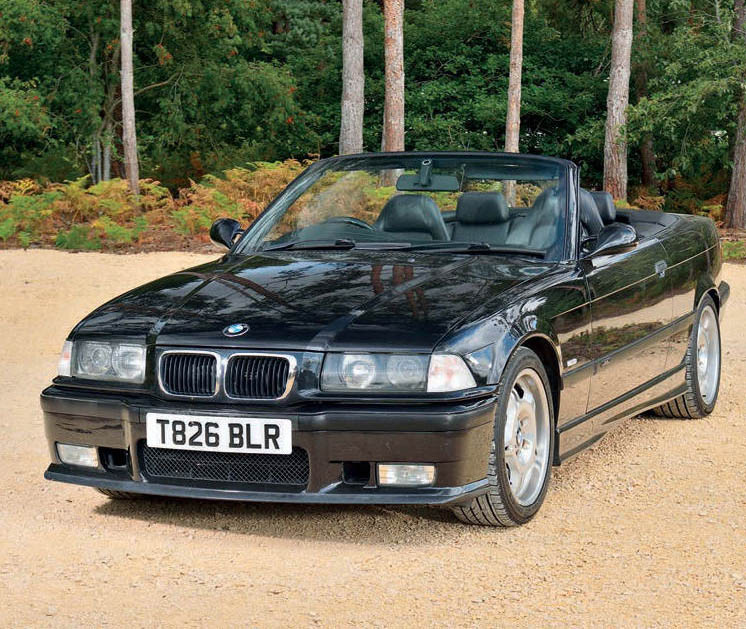
The new 3 Series was already a hit by then. Launched as a saloon in 1991, it had been styled with careful consideration given to its aerodynamic abilities, but the old E30 convertible remained until its E36 successor arrived in 1993. Launched as a 325i, the range expanded to include the 320i and the four-cylinder 318i. Later 323 and 328 models replaced the 320 and 325, while an M3 model became available for those determined to make a proper mess of their hairdos.
“’IT'S A TASTE OF THE HIGH LIFE FOR FIESTA MONEY"
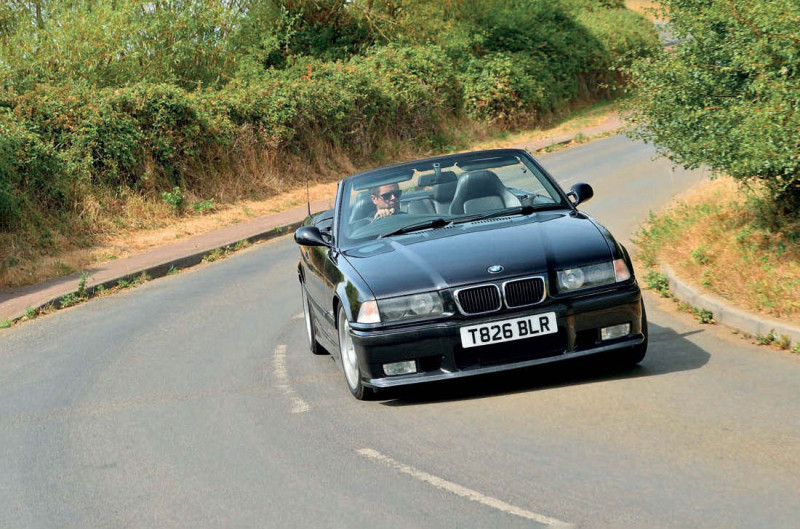
The E36 3 Series convertible was discontinued in 1999, ready for the launch of the new E46-series convertible in December of that year. It was the final E36 model, the saloon having been replaced first in 1998. We’ve borrowed this 1999 BMW M3 Convertible from Anglia Car Auctions. It’s a late car, meaning a 3.2-litre engine and six-speed gearbox, and its Cosmos Black paint sits nicely with the Black Nappa leather. From behind the wheel, it’s a car that means business – even if the overall dashboard shape put us in mind of a Citroën Xsara, the Motorsport three spoke steering wheel and sports seats lend it a purposeful air. There are far more buttons in here than in the Mercedes too, courtesy of its range-topping position. What does feel to be lacking is quality in the plastics and the switches – they’re well enough engineered, but feel light and cheap in comparison to those of the E220. Unlike Mercedes, BMW also supplied its convertibles with an optional hardtop, which this car retains. With a centrally mounted handbrake, the key on the right and the indicator stalk on the left, the layout is far more conventional than the Mercedes, while it’s tractable enough at low revs to belie the true power of the engine.

The seats hug you more firmly than those of the Mercedes, while the dashboard shape contributes to its driver-focused environment. The six-speed box is slick, and there’s plenty of acceleration – though it’s more refined and serene than you’d expect of an M car if your only exposure had been the E30 that came before. It feels more like a replacement for the M635CSi than for the old M3, and that’s not a bad thing. It’s somehow softer than both the car it replaced and the car that replaced it – feeling like the ideal starter car for someone new to the M family but not ready for something truly hardcore. That doesn’t make it a pudding though, this is a car with a well-balanced chassis and sorted handling. The suspension is far firmer than that of the Mercedes, but it’s not intrusive and it’s certainly well-enough damped. The steering is quick and nicely weighted, and the gear ratios have been well chosen to make the most of this car’s 317bhp potential. On a winding B-road, this M3 could be a lot of fun – far more fun than the Mercedes, but that isn’t necessarily enough to guarantee it victory. Because in day-to-day life, the situations where you can exploit this power are few and far between.

The M3's 3.2-litre M52 engine is a real monster, but can still be docile in traffic.
It also feels like BMW chose to focus more on the driving dynamics than the practicalities of open-roofed life. While the hard top is easy enough for two or three people to remove and refit (and given its size, we can’t expect it to be a one-man job), with the roof down there’s a lot of buffeting around the screen frame, and any long-haired passengers will find that their locks simply won’t stay still. For creating a sensation of speed it’s fun, but not if you want to get out looking as sophisticated as you might feel. Each car has pros and cons, then – but which one will prove victorious?
LIVING WITH THEM
In both cases, the hood is the biggest worry you’re likely to have – check that the electric mechanism works properly, the material isn’t marked or torn and that the rear screens are intact and well-fitted. Beyond that, the issues you’ll face are similar to the fixed head equivalents. On the Mercedes that means that there are two primary concerns: corrosion and wiring. They can corrode almost anywhere, but typical trouble spots include the front wings, sills and floors so check carefully for any undesirable grot. In terms of wiring, all 16- and 24-valve models from 1992 onwards used a new type of Mercedes-Benz loom designed to biodegrade over time, along with all Mercedes models built between 1992 and 1996. As Mercedes didn’t envision the long-term use of these vehicles they have often begun to biodegrade while in service.
Replacement isn’t cheap, so check for an invoice to be certain it has already been done. Head gaskets can fail, but typically only through hard use when cold – it’s still worth checking for mayo under the oil cap. Earlier eight- and 12-valve engines are virtually indestructible.
Back arches, all four wings and the floors can rot out on the BMW, too. The sills are also prone to corrosion, rotting around the jacking points and where the seam sealer connects the sill to the floor. If the car you’re looking at has sill covers, odds are that the sills are rotten behind them. Four-cylinder examples are unburstable, as are the earlier M50 sixes. Early M52s, though, can suffer with bore wash and damage to the Nikasil cylinder coatings. Don’t ever turn off an M52-engined car without allowing it to warm through, but if they start and run nicely there’s no reason to avoid them.
If you want a W124 convertible of any kind these days, be prepared to spend serious money – though thankfully not as much as £40,000. Bank on around £10,000 today for anything worth having, whether four- or six-cylinder. The nicest six-cylinder can fetch between £15,000 and £20,000 if it has the right sort of history file with it. The BMWs can be a lot cheaper, starting at around £2500 for a 318i in average condition and rising up to around £10,000 for the nicest 328is. M3s are more expensive, but even then it’s hard to find an E36 convertible that sells for more than around £17,000.
VERDICT
While we were out shooting these two cars together, we asked several members of the public which they would rather take home. Every single one chose the BMW, whether male, female, old or young. Our photographer, Matt Woods, also voted with his feet and claimed the BMW would be a better fit alongside the 911 Turbo he keeps in his garage.
Here’s the thing though, they’re all wrong. Because while the M3 is a very capable car at what it does, the fact remains that it’s still a £25,000-whennew 318i convertible with a nice engine, chassis and drivetrain. That means you get £25,000 plastics, £25,000 hood engineering and £25,000 quality – and we don’t think that the drivetrain makes up for that. In modern traffic, you can’t exploit the power to the full without looking like the stereotypical M3 driver, getting too close to the car ahead and then backing off for another go. While on an autobahn it would make sense, in Britain the extra power means extra thirst and maintenance expense. Then there’s the wind turbulence – for long-haired people like me, it will remould your barnet into a passable Phil Oakey tribute through buffeting from the side. The Mercedes doesn’t have the same issues, with a better-designed aerodynamic profile, buffeting is kept to a minimum and your hair behaves sensibly. The interior trim feels far nicer, you feel more special behind the wheel, and while it’s not as fun when the road is free and winding, 95 per cent of the time it’s a nicer place to be. And because the money wasn’t spent on the drivetrain, the rest of the car feels far more thoroughly engineered. There’s also something special about looking down the bonnet and aiming the three-pointed star into the horizon. You feel more special than in the BMW, regardless of the relative sparsity of spec. Yes, the Mercedes is the slower car. But you won’t use the power anyway. And with 35mpg a real possibility, it’ll cost you much less to soak up the rays in style.
Kim Cairns Classics (www.kimcairnsclassics. co.uk) for supplying the Mercedes-Benz E220, and Anglia Car Auctions (angliacarauctions.co.uk) for providing the BMW M3 Evolution.
The M3's poised chassis has its driver relishing the prospect of twisty B roads. With its chunky wheels and bodykit, the M3 has a very purposeful stance.
“IN MODERN TRAFFIC, YOU CAN’T EXPLOIT THE POWER TO THE FULL”
THE FACTS
- MODEL Mercedes-Benz E220 Cabriolet A124 / BMW M3 Convertible Evolution E36/2CS
- ENGINE 2199cc in-line four 3201cc in-line six
- TRANSMISSION Four-speed automatic Six-speed manual
- MAX POWER 148bhp 317bhp
- 0-60 MPH 10.6 seconds 5.6 seconds
- MAX SPEED 134mph 155mph
- LENGTH 4655mm 4433mm
- WEIGHT 1610kg 1635kg
Pace or grace? The M3 is faster, but the E220 has plenty of redeeming qualities.
The subtle Mercedes has a timeless, classy feel to it.
They cost similar amounts when new, but these cars are very different in character.


